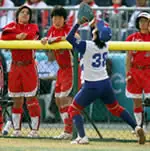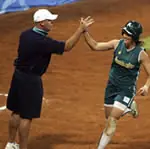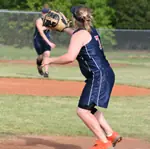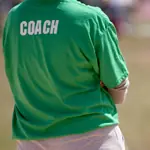
Stopping your opponent's running game can be a pivotal advantage, especially in close games. Unfortunately, many catchers lack good form because coaches don't work enough with them on defending the second base steal. The best way to correct catching form is to practice game-like situations without actual runners.
Here is a practice technique to improve your team's run defense and reduce your opponent's scoring chances dramatically.
Step 1: Set-Up and Preparation
Start with the pitcher standing in the circle with a bucket of balls. The catcher is to be behind home plate in full equipment in the crouch position. (This should be with thighs parallel to the ground, a fairly wide stance for balance and their left foot slightly in front of the right. This is reversed for left- handed players.)
Draw a straight line across the ground in line with the left foot. The catcher should extend their left hand (glove hand) out and make a fist with the thumb tucked inside. The right hand should be placed behind the glove pocket. This will enable better control and a faster throw to second.
Step 2: Proper Position
Have the pitcher throw a regular fastball down the middle of the plate. The catcher is to lean forward slightly to get to the ball faster. As the catcher is catching the ball they should turn their feet so their right foot is perpendicular to the position that the left foot was in. They should not have taken any steps toward the pitcher except the shuffle turn. Note: The left foot should be open to second base; this allows the throwing arm to be in a straight line with second base.
With the upper half of their body, they should be in a sitting position with their back straight (like a wall-sit.) The ball is pulled with both hands up to the right of their face by their ear. The left arm should then separate from the right and point to second base. With the ball in the extended right arm that is parallel to the ground, bend the arm to a 90-degree angle and have the hand toward the sky. Rotate the right wrist backwards (as if to show the python muscle.)
Step 3: Making a Good Throw
With each throw, the catcher should have the same grip on the ball. I use the grip with my index, middle and ring fingers crossing the seams. Keeping the "L" shape in their arm, they should follow-through the throwing motion and keep it in line with second base. Their weight should shift with the throw. (Make sure not to shift the weight too soon, as this will create less speed on the ball.) The left arm should release and fall as the right arm throws the ball.
Step 4: Follow-Through
Your follow-through should force your right foot into the fielder's position. The ball should be going on a down angle to second base, not a straight line. This will better enable the shortstop or second baseman to put the tag on. (The receiver's glove should start on the ground and be pulled up for bad hops, not started in the air as is often taught.) The catcher should not be stepping on the plate or anywhere near the plate.
After this is done repeatedly--and don't worry it is not to be learned in one day!--try other pitches. For a ball on the glove side, the ball should be pulled across the body with both hands and into the throwing position. The body should not go to where the ball is.
 See more softball drills & workouts or find a softball league near you.
See more softball drills & workouts or find a softball league near you.








Discuss This Article